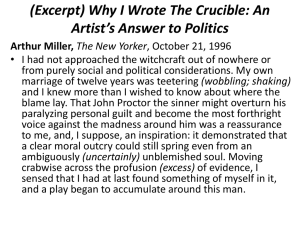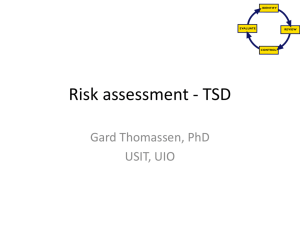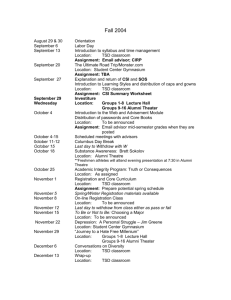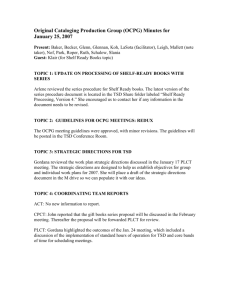Wobbling Mode in Tantalum-167 Ryan Pifer US Naval Academy Physics Department
advertisement
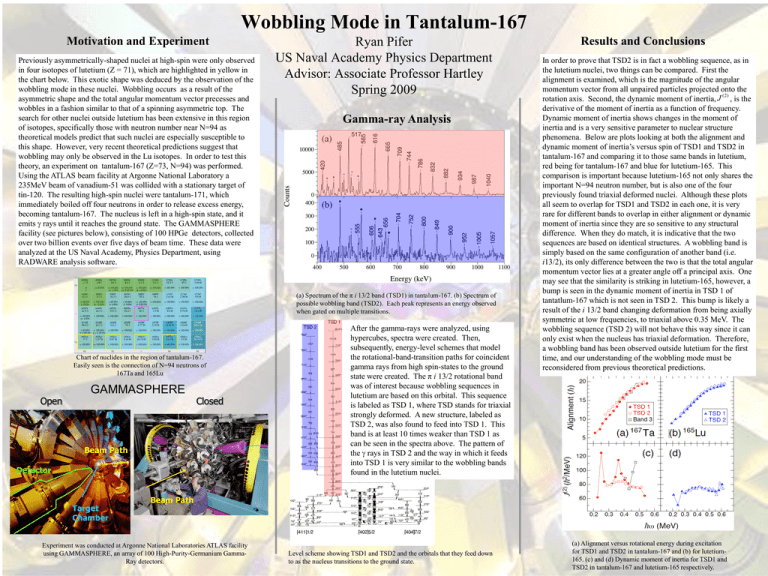
Wobbling Mode in Tantalum-167 Motivation and Experiment Previously asymmetrically-shaped nuclei at high-spin were only observed in four isotopes of lutetium (Z = 71), which are highlighted in yellow in the chart below. This exotic shape was deduced by the observation of the wobbling mode in these nuclei. Wobbling occurs as a result of the asymmetric shape and the total angular momentum vector precesses and wobbles in a fashion similar to that of a spinning asymmetric top. The search for other nuclei outside lutetium has been extensive in this region of isotopes, specifically those with neutron number near N=94 as theoretical models predict that such nuclei are especially susceptible to this shape. However, very recent theoretical predictions suggest that wobbling may only be observed in the Lu isotopes. In order to test this theory, an experiment on tantalum-167 (Z=73, N=94) was performed. Using the ATLAS beam facility at Argonne National Laboratory a 235MeV beam of vanadium-51 was collided with a stationary target of tin-120. The resulting high-spin nuclei were tantalum-171, which immediately boiled off four neutrons in order to release excess energy, becoming tantalum-167. The nucleus is left in a high-spin state, and it emits rays until it reaches the ground state. The GAMMASPHERE facility (see pictures below), consisting of 100 HPGe detectors, collected over two billion events over five days of beam time. These data were analyzed at the US Naval Academy, Physics Department, using RADWARE analysis software. Ryan Pifer US Naval Academy Physics Department Advisor: Associate Professor Hartley Spring 2009 Gamma-ray Analysis (a) Spectrum of the π i 13/2 band (TSD1) in tantalum-167. (b) Spectrum of possible wobbling band (TSD2). Each peak represents an energy observed when gated on multiple transitions. Chart of nuclides in the region of tantalum-167. Easily seen is the connection of N=94 neutrons of 167Ta and 165Lu Open GAMMASPHERE Closed Beam Path Detector Target Chamber After the gamma-rays were analyzed, using hypercubes, spectra were created. Then, subsequently, energy-level schemes that model the rotational-band-transition paths for coincident gamma rays from high spin-states to the ground state were created. The π i 13/2 rotational band was of interest because wobbling sequences in lutetium are based on this orbital. This sequence is labeled as TSD 1, where TSD stands for triaxial strongly deformed. A new structure, labeled as TSD 2, was also found to feed into TSD 1. This band is at least 10 times weaker than TSD 1 as can be seen in the spectra above. The pattern of the rays in TSD 2 and the way in which it feeds into TSD 1 is very similar to the wobbling bands found in the lutetium nuclei. Results and Conclusions In order to prove that TSD2 is in fact a wobbling sequence, as in the lutetium nuclei, two things can be compared. First the alignment is examined, which is the magnitude of the angular momentum vector from all unpaired particles projected onto the ( 2) rotation axis. Second, the dynamic moment of inertia, J , is the derivative of the moment of inertia as a function of frequency. Dynamic moment of inertia shows changes in the moment of inertia and is a very sensitive parameter to nuclear structure phenomena. Below are plots looking at both the alignment and dynamic moment of inertia’s versus spin of TSD1 and TSD2 in tantalum-167 and comparing it to those same bands in lutetium, red being for tantalum-167 and blue for lutetium-165. This comparison is important because lutetium-165 not only shares the important N=94 neutron number, but is also one of the four previously found triaxial deformed nuclei. Although these plots all seem to overlap for TSD1 and TSD2 in each one, it is very rare for different bands to overlap in either alignment or dynamic moment of inertia since they are so sensitive to any structural difference. When they do match, it is indicative that the two sequences are based on identical structures. A wobbling band is simply based on the same configuration of another band (i.e. i13/2), its only difference between the two is that the total angular momentum vector lies at a greater angle off a principal axis. One may see that the similarity is striking in lutetium-165, however, a bump is seen in the dynamic moment of inertia in TSD 1 of tantatlum-167 which is not seen in TSD 2. This bump is likely a result of the i 13/2 band changing deformation from being axially symmetric at low frequencies, to triaxial above 0.35 MeV. The wobbling sequence (TSD 2) will not behave this way since it can only exist when the nucleus has triaxial deformation. Therefore, a wobbling band has been observed outside lutetium for the first time, and our understanding of the wobbling mode must be reconsidered from previous theoretical predictions. Beam Path Experiment was conducted at Argonne National Laboratories ATLAS facility using GAMMASPHERE, an array of 100 High-Purity-Germanium GammaRay detectors. Level scheme showing TSD1 and TSD2 and the orbitals that they feed down to as the nucleus transitions to the ground state. (a) Alignment versus rotational energy during excitation for TSD1 and TSD2 in tantalum-167 and (b) for lutetium165. (c) and (d) Dynamic moment of inertia for TSD1 and TSD2 in tantalum-167 and lutetium-165 respectively.
